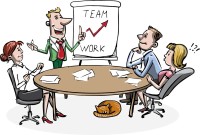- Home
- Business Processes
- Industry Knowledge
- Aerospace Industry
- Automotive Industry
- Banking Domain
- BFSI Industry
- Consumer/ FMCG Industry
- Chemicals Industry
- Engineering & Construction
- Energy Industry
- Education Domain
- Finance Domain
- Hospitality Domain
- Healthcare Industry
- Insurance Domain
- Retail Industry
- Travel and Tourism Domain
- Telecom Industry
- Leadership Skills
- eLearning
- Home
- Leadership
- Creativity Tools
- Thinking & Problem Solving Skills
Thinking & Problem Solving Skills
Today's dynamic business world demands that you make decisions that significantly boost productivity and drive competitive advantage. But how do you know whether a decision will benefit the organization? And how do you know that the decisions are based on rational and statistical reasoning? Explore how to become a dynamic problem solver with the skills to make accurate decisions.
Definitions of Problem Solving
Problem-solving is a set of activities designed to analyze a situation systematically and generate, implement, and evaluate solutions.
Problem Solving is the seeking of solutions to problems that arise in an organization.
A problem is an intricate unsettled question: a source of perplexity, distress, or vexation. The problem-solving process leads to the formulation of decisions intended to resolve the recognized problems.
The problem refers to the existence of a gap between where a person is and where one would like to be. The thought process involved in a person's effort to remove obstacles in the way to achieve the goal state is called problem-solving.
Problem-solving begins with a certain original state called the initial state of a problem. Problem-solving behavior begins with an obstacle or difference between the original or initial state and goal or end state. The goal is desired by the operator in the situation and has some properties defined by the operator to convert the problem state into the goal state.
Benefits of Effective Problem-Solving Skills
- Ability to make decisions more rationally and wisely
- Avoid making wrong decisions
- Avoid a variety of irrational ideas, false assumptions, and other emotions
Approaches to Problem Solving
What are the principles of sound decision making and different decision-making styles? How do you measure the return-on-investment of your decisions? How to make decisions with business partners who might not see the world the same way you do?
There are many approaches to problem-solving, depending on the nature of the problem and the people involved in the problem.
Rational Approach
The rational approach involves clarifying, giving a description of the problem, analyzing causes, identifying alternatives, assessing each alternative, choosing one, implementing it, and evaluating whether the problem was solved or not.
Appreciative Inquiry
This approach asserts that "problems" are often the result of our own perspectives or a phenomenon. For example, if we look at a particular situation as a "problem," then it will become one and we'll probably get very stuck with the "problem". The appreciative inquiry includes identification of our best times about the situation in the past, wishing and thinking about what worked best then, envisioning what we want in the future, and building from our strengths to work toward our vision.
Steps in Problem Solving
In an organizational context, one should adopt rational and creative approaches to problem-solving. Using a problem-solving approach and tools you can achieve the right mindset for problem-solving, can brainstorm alternatives, and analyze the problem using analogies, idea nets, and mind mapping and eventually visualize the best solution to your problem. Given below are generally accepted steps to problem-solving:
1. Identify the problem
Problem identification is undoubtedly the most important and the most difficult step in the process. All subsequent steps will be based on how you define and assess the problem at hand. A problem is a situation or condition of people or the organization that exists but members of the institution consider that undesirable.
2. Exploring the Alternatives
The second step in the problem-solving process is to explore alternative solutions to the problem identified in step 1. In this step one tries to generate and evaluate alternatives by doing brainstorming, taking surveys or facilitating discussions.
3. Selecting an Alternative
The third step in the problem-solving model is to select one of the alternatives. After one has evaluated each alternative, one alternative needs to be selected that would come closest to solving the problem with the most pros and minimum cons.
4. Implementing the Solution
The fourth step involves developing an action plan and implementation by arranging funding, resources, timelines, and target objectives. Resources include people, information (data), and things. The plan should state who will do what and when. And finally, implement the action plan to put the decision in place.
5. Evaluating the Solution
Evaluation means to monitor the progress to establish if the situation has changed and the problem has been resolved. Evaluating the results to declare the success of the alternative deployed.
Related Links
You May Also Like
-
Many different types of teams have been identified by social scientists. Managers may encounter the diverse types of challenges while managing different kinds of teams. Challenges associated with Cross-Functional Teams might be different from that of a Geographically Dispersed Team or a Virtual Team. This article explores some common categories and subtypes of teams.
-
Building Perfect Creative Team
One misconception around creativity is that creative act is essentially solitary. Most of the world's important inventions resulted not from the work of one lone genius, but from collaboration of a team with complementary skills. Managers should build teams with the ideal mix of traits to form a creative group and then establish the conditions that make creativity much more likely to occur.
-
Authoritarian Leadership Style
Although generally considered as a traditional, outdated, and non-preferred style of leadership, the autocratic style still can be used effectively in certain situations. It is a leadership style characterized by individual absolute control over a group. If you work for an autocratic leader, your job is usually to do what you're told. Learn more about this style and situations where this could be an effective style to use and when to avoid this type of approach. Analyze the characteristics of this style to evaluate if your followers consider you an authoritarian leader!
-
Time management is the process of planning and exercising conscious control of time spent on specific activities, especially to increase effectiveness, efficiency, and productivity. The best time management techniques improve the ways you work. Time management refers to managing time effectively so that the right time is allocated to the right activity. Learn more about the five steps for effective time management viz. study, identify, analyze, decide, and implement.
-
Reasons behind Wastage of Time
Under-utilization of time may be due to the faulty system or faults of manager/officer/leader or due to lack of planning. There could be many factors driving the procrastination behavior like system issues, personal work habits, and lack of delegation, personality traits, and bad working habits of the leader, failure to tackle interpersonal conflicts, obstacles, and lack of far-sightedness.
-
In its simplest sense, decision-making is the act of choosing between two or more courses of action. Decision making is a key skill in the workplace and is particularly important if you want to be an effective leader. When decisions have to be made, there are several stages that you should go through to reach a practical solution. Understand the meaning and importance of decision making and how to look at it as a process.
-
Generating Ideas using SCAMPER
SCAMPER is an activity-based thinking process that can be performed by Cooperative learning. SCAMPER is an acronym that provides a structured way of assisting students to think out of the box and enhance their knowledge. This can be used in the organizational context as a technique for creative problem solving and as a toolkit to generate fresh ideas.
-
Concept & Definition of Stress
Stress is a popular expression used by people in day to day life. Pressures of day to day living sometimes necessitate coping or dealing with them and stretch the body beyond its natural capacity. They are called stressors. Stress is a natural, ongoing dynamic, and interactive process that takes place as people adjust to their environment.
-
Participative leadership is one of the most effective styles and creates higher productivity, better contributions from group members, and increased group morale. The democratic leadership style consists of the leader sharing the decision-making abilities with group members by promoting the interests of the group members. Learn more about this leadership style and situations when it is effective.
-
Creating Highly Effective Teams
How do we create effective teams? What comes to mind when you think about an effective team? High performing teams exhibit accountability, purpose, cohesiveness, and collaboration. It is a team that works seamlessly as a whole. Everyone brings unique talents and strengths and support each other to bring out the best in everyone. How do you create one?
Explore Our Free Training Articles or
Sign Up to Start With Our eLearning Courses

About Us
Learning
© 2023 TechnoFunc, All Rights Reserved










